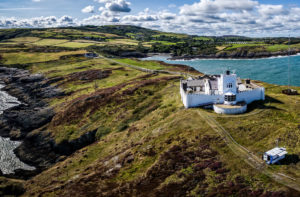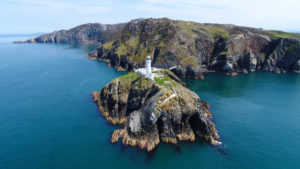This beautiful part of the world that we are lucky enough to call home has some of the most stunning coastlines that I have ever encountered. With an abundance of Blue Flag Beaches, water sports enthusiasts, swimmers, walkers and rock-poolers love spending weekends and holidays here.
However, as stunning as the coastline is, the seas away from the sheltered beaches are as treacherous as you will find. For years, lighthouses have stood on the edge of our shorelines, guiding ships to safety. For the old sailing ships, it was paramount that these stages of their journeys home, or to port, were as safe and protected as possible.
Other lighthouses have been converted into cosy cottages in locations that take some beating. All these amazing lighthouses in North Wales are great places to visit whether via boat, or foot, weather permitting!
Point Lynas
What better place to start than Point Lynas Lighthouse on the northern coast of Anglesey. The current lighthouse was built in 1835 and is still operational. The owners live in the head keeper’s cottage, and you can stay in the East and West Keepers Cottages with Menai Holiday Cottages.
The views are stunning and on clear days it is possible to see Ireland, the Isle of Man, Dumfries and Galloway, the Lake District and the Clwydian Range. Porpoises live almost permanently off the end of the headland and can easily be seen on calmer days. If you are very lucky you could catch sight of a Pilot whale, Minke whale or even an Orca!
It is also a hotspot for bird watchers. A great way to view the lighthouse is to walk from the nearby historic port of Amlwch.

South Stack
One of the most photographed lighthouses in North Wales is at South Stack. The tiny islet known as South Stack Rock lies separated from Holyhead Island by a thirty-metre churning channel and perched on steep cliffs that rise up from the sea to over sixty metres.
It wasn’t until 1809 that the first light appeared to mark the rock for sailors. On 25th October 1859, one of the most severe storms of the century battered the coast. Over two hundred vessels were either driven ashore or totally wrecked and eight hundred lost their lives. The steamship Royal Charter was among these.
Fortunately, in 1984 the lighthouse was automated and the keepers stationed elsewhere. A cable 21m above sea level used to link the lighthouse to the mainland. Along this, a sliding basket was drawn carrying a passenger or stores, in the style of the book The Lighthouse Keepers Lunch.
This system was eventually replaced by a suspension bridge which is handy as the landward approach to the bridge is by descending 400 steps cut into the cliff face! The island and the lighthouse were reopened to visitors in 1997 and are now part of an RSPB bird reserve.

North Stack
This isn’t actually a lighthouse, however, history links it to South Stack. In the “olden days,” going back to the early 1800s, sophistication went out of the window when it came to warn ships off the Holy Island rocks.
A huge cannon was fired from the clifftop to warn all that “Here are some cliffs!” The cannon was used along with the fog warning bell that was located at South Stack Lighthouse.
Both were eventually replaced by a fog siren. The foghorn station and gunpowder store are now redundant. The views from North Stack are staggering as you are surrounded by steep sea cliffs with seals and porpoises below and hundreds of noisy seabirds above.
Trwyn Du
In the 1800s, Liverpool master pilots felt it was essential to have a light on the shore at Black Point, or Trwyn-du. The lighthouse is situated on a low-lying rock surrounded by beaches about half a mile south of Puffin Island. The circular stone tower is distinguished by three wide black bands.
Trwyn Du Lighthouse was converted to solar power in 1996. We like the walk out to the headland at Penmon Point, which has lovely views over towards Puffin Island, and back across the Menai Strait to Snowdonia.
When it was built in the 1830s, the lighthouse featured a flushable lavatory, which was supposed to stop seawater from surging back up the pipe from the sea below. It never actually worked, which explains why it has been unmanned since 1922.
Skerries
One of the most well-known lighthouses in North Wales is Skerries. Skerries Lighthouse stands proudly at the end of a strip of submerged land north-east of Holyhead which lies directly in the path of many of the major shipping lines from Liverpool and Ireland.
The Skerries get their name from the Gaelic word “sgeir” meaning “rocky islet,” in Welsh they are known as Ynys Y Moelrhoniaid which means “Islands of Bald Headed Grey seals.”
This lighthouse marks the most north-western point of Wales and is one of the most important lights of the Irish Sea. The round white and red, cylindrical, stone tower with lantern and gallery are attached to a two-storey keeper’s house.
The RSPB manages the island reserve although the islands are owned by Trinity House. The islands also hold significant numbers of breeding terns, herring and lesser black-backed gulls and large numbers of breeding puffins. Local companies charter boats leaving from Holyhead to view these stunning islands in more detail and to see the lighthouse up close.

Holyhead Breakwater
The Holyhead Breakwater Lighthouse stands on the Holyhead Breakwater just outside the port itself. You cannot fail to be impressed by its sheer presence of the breakwater itself, all 1.48 miles of it, quarried from the old Holyhead quarry, nearby.
The three-storey black and white tower, unlike many contemporary lighthouses, is square for the obvious reason that it made day to day living in the lighthouse more comfortable.
In the 19th century, ships approaching Holyhead in the fog would be warned by a bell operated from the lighthouse. In the late 1870s, this was supplemented with rockets that would complement the cannon fired from the fog warning station on North Stack.
Take a fishing rod or your bike and enjoy the trip down the longest breakwater in the UK to the lighthouse itself.
Llanddwyn Island
The lighthouses here are redundant but well worth a mention in the run-up to Valentine’s day as it could be argued that there isn’t a more romantic spot in Wales than Llanddwyn Island, one of the most beautiful islands of Wales.
A lovely walk is out through the Newborough Warren National Nature Reserve onto a slim, sand-fringed island, past the ruins of a chapel dedicated to St Dwynwen, the Welsh patron saint of lovers, and at the tip, a pair of basic whitewashed lighthouses Tŵr Mawr and Tŵr Bach. The whole place is stunning and quite romantic.
In 2004 the light station even appeared in the movie “Half Light” starring Demi Moore. The dunes, large rocky outcrops and mixture of historic buildings make for an ideal place to explore as a family and there is something to keep everyone interested.
On a more practical note – situated near the southern entrance to the Menai Strait, the stretch of water became important in the shipping of slate from the Welsh ports of Bangor, Caernarfon and Y Felinheli increased. The beacon, called Tŵr Bach, was built at the tip of the island to act as a guide to ships heading for the Strait.

Bardsey Island
The small island of Bardsey separated from the mainland and the fishing village of Aberdaron, by the Bardsey Sound, a stretch of water well known to sailors as being particularly dangerous.
The island, which is two miles long by half a mile wide, is surrounded by outcrops of sharp rocks and dangerous seas. With a rich history going back thousands of years, there was a real need for a lighthouse on the island.
Bardsey Lighthouse stands on the southerly tip of the island and gives a guide to ships passing through St George’s Channel and towards the Irish Sea. The red and white striped, square tower was built in 1821 and became automated in 1987. You can visit the island itself by a charter boat from the fishing village of Aberdaron, weather permitting through Bardsey Boat Trips.
Holyhead Main Pier
Another historically important, but now redundant lighthouse in North Wales is located at the end of the pier at Salt Island, marking the north side of the entrance to the harbour in downtown Holyhead.
Holyhead Main Pier is a conical white house and is possibly the second oldest lighthouse in Wales. The lighthouse is of national significance as one of the eminent engineers of the industrial revolution, John Rennie’s, surviving works.
The tower survives today and has beautifully curved gallery railings, similar to those in Bardsey Island Lighthouse. It is no longer in use, although it is used as a navigation reference for sailors.
St. Tudwal’s
St Tudwal’s Lighthouse is situated on the small island of St Tudwal’s Island West can be seen from Abersoch beach. It marks the north end of Cardigan Bay to sailors. Located half a mile offshore, the lighthouse and island have gained something of a celebrity status after Bear Grylls and his family purchased the lighthouse keepers cottage some years back.
The site of the lighthouse was purchased by Trinity House in 1876. It was modernised and converted to solar-powered operation in 1995. The island itself is private, however, local charter companies including Abersoch Angling, offer trips around the islands to see the abundant wildlife, including grey seal, dolphins and the thousands of birds that nest there.

If this post has piqued your interest, why not book a stay in a North Wales holiday cottage through us? Book online, or give us a call on 01248 430258 and speak to one of our travel experts who all live in and love the area.